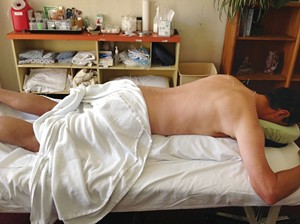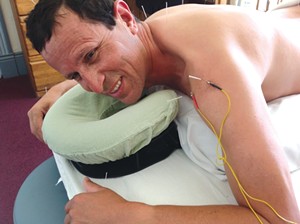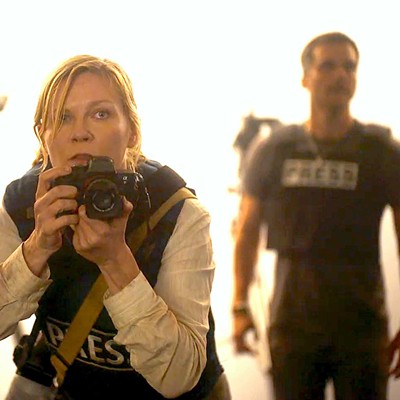
Danilo Perez—a retired Santa Maria physical education teacher and avid runner—lies flat on his stomach, breathing deeply. While the tiny needles sticking out of his back might indicate some kind of masochism, Perez is actually finishing up another monthly acupuncture treatment.
“Treatment is like a tune-up,” Perez said. “Acupuncture is part of my regimen.”
Perez, now 53 years old, has been running for 37 years. A former track star and marathoner, Perez continues to run—seven miles, four times a week. But after many years of running, he could no longer ignore the chronic pain in his hip.
“Curiosity and a documentary on PBS drew me to acupuncture,” he said.
The runner has dutifully received treatments from Dr. Herb Kandel at the Acupuncture Center of Santa Maria for 17 years. Perez is among a growing number of athletes, both local and professional, who are turning to acupuncture to treat a variety of musculoskeletal issues.
According to a recent article in The New York Times, the National Football League employs its own acupuncturist who treats 40 players; Olympic-level teams are also seeing the benefits of acupuncture treatment.
“Acupuncture is a great tool for sports medicine and helps athletes tune in to what their body is telling them,” said Kandel, who opened his Santa Maria practice 26 years ago.
He has extensively studied anthropology and Chinese medicine, and he treats patients from all walks of life—from rugby players to dancers. More and more of Kandel’s patients are coming to him with sports-related ailments.
Acupuncture, for those who don’t know, is more than just needles and alternative doctors. According to Kandel, acupuncture is one of the oldest forms of Chinese medicine with the longest history of continuous care.
The treatment involves the placement of very thin, sterile, disposable needles into acupuncture points on the body. By strategically inserting these needles, Kandel said, the body will respond physiologically, to incite a healing response.

“The immune system will recognize a foreign object and will increase circulation to injured areas,” he said.
Acupuncture treatments also increase neurological signals; the brain even responds during treatment, releasing serotonin to help the body relax. Kandel said the nervous system will also respond to treatment, increasing healing to the distal points of the body as well.
“I feel sedated and relaxed during treatment,” Perez said. “It gives you a chance to get some tranquility.”
While the use of needles might make some squeamish, Perez said the pain from the pricks is minimal. Although acupuncture has been around for centuries, the “taboo” practice has taken longer to break into Western medicine. But, according to Kandel, more clinical studies are supporting the numerous benefits of acupuncture treatment.
“Acupuncture helps with chronic injuries, insomnia, stress, anxiety, and auto-immune diseases,” Kandel said. “It is now being considered a complementary medicine to be used alongside Western treatment.”
The practice will become even more mainstreamed in 2014, when the Affordable Care Act will mandate that insurance companies provide coverage for it as a treatment option. The healing powers of acupuncture are being even more widely realized in the world of athletics by athletes of all ages and skill levels. Kandel said about 50 percent of his clientele is active. His clients turn to acupuncture because nothing else works or they want to be proactive.
Kandel has treated his share of worn-out football and baseball players, runners, and dancers. Athletes, who are often on a rigorous training schedule, are drawn to acupuncture because it can cut recovery time by half, he said.
In addition to increasing blood circulation, acupuncture prompts the body to release its own organically produced anti-inflammatory and pain reducers, which lend a helping hand to healing.
“During treatment, the body will release cortisol, serotonin, and other healing endorphins,” Kandel said. “Acupuncture is widely known for pain relief.”
Perez now sees acupuncture as a form of “vehicle maintenance” that has kept his body in running condition much longer than other runners.
“I get lactic acid build-up in my legs; they feel heavy and tired before treatment,” Perez said. “But afterward, the toxicity clears up and my legs feel like feathers.”
Acupuncture is also great for treating chronic injuries that tend to plague athletes, such as tendonitis and scar tissue. Perhaps one of the more amazing benefits of acupuncture is that it greatly reduces dependence on pain medication.
Take, for instance, Maria Junco, a professor at Cal Poly in SLO who ran the university dance company for more than 17 years. She came to acupuncture with persistent back and neck problems, and has endured a couple of major back surgeries in the last couple of years. The most recent surgery involved a four-level disc fusion in her back.
“It’s pretty amazing what [acupuncture] does,” Junco said. “It’s very effective in reducing stress resulting from surgery; acupuncture opens up healing pathways after trauma.”
Junco—who also believes acupuncture kept her dancing longer than doctors thought she would—hasn’t used post-surgery medication for pain.
For Kandel, when it comes to treating his more active clientele, there is also an essential learning component that comes with this kind of treatment. Athletes are often pushed to their physical limit with no time to heed warning signs from the body. Kandel said acupuncture treatments help athletes rest (an important aspect for performance) and pay attention to their bodies.
“The healthiest athletes will recognize limits, ask for help, and nourish as deeply as they exert,” he said.
Kandel has observed athletes learn more about their bodies and establish a better balance of activity and rest. As for the future of the treatment’s continued use in athletics, Kandel thinks the value of acupuncture will continue to increase as coaches and parents introduce younger generations to it more frequently.
“It will help athletes make good choices about health and maintenance,” he said. “Acupuncture gives confidence to the athlete and shows the body’s remarkable capacity to heal itself.”
Staff Writer Kristina Sewell could use a tune-up in
her right shoulder. Contact her at ksewell@santamaria
sun.com.









